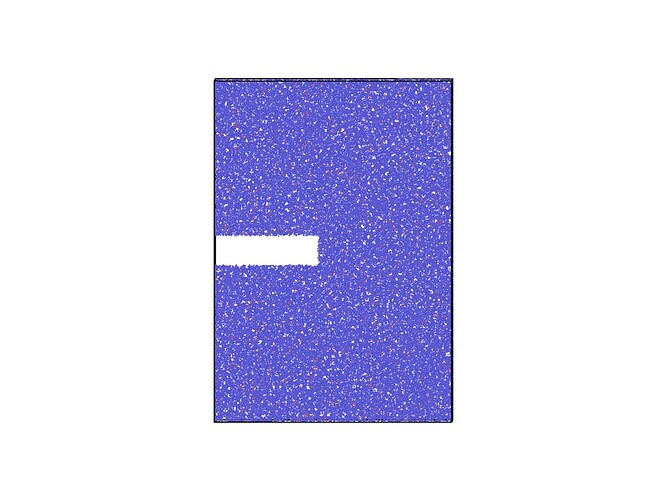I want to do the crack simulations. I have created the notch by deleting the atoms (white patch region), and now I am pulling the sample in the z-direction. The condition i am giving is
units real
boundary p p p
atom_style full
bond_style harmonic
dihedral_style opls
pair_style lj/cut/coul/cut 6.0 12.0
read_data system_notched_sample
region 1 block EDGE EDGE EDGE 70 EDGE 168 units box
region 2 block EDGE EDGE EDGE 70 182 EDGE units box
group lower region 1
group upper region 2
set group lower type 3
set group upper type 4
pair_coeff 1 1 0.2104 3.7654
pair_coeff 2 2 0.0862 4.0685
pair_coeff 3 3 0.2104 3.7654
pair_coeff 4 4 0.2104 3.7654
pair_modify tail yes
neighbor 1 bin
neigh_modify exclude type 3 4 # As given in lammps documentation this will turn off the interaction
fix 1 all npt 100 100 500 x 0 0 100 y 0 0 100
variable srate equal 1.0e10
variable srate1 equal “v_srate/ 1.0e15”
fix 2 all deform 1 z erate ${srate1} units box
run 50000
As soon as I started pulling the sample, the white patch was filled by the particles, and the density changed it is due to the interactions that were happening.
I read the lammps documentation and there is one example given in the folder i.e. 2d cracks problem, they have used the neigh_modify command to turn off the interaction between the two regions at the crack tip so that crack can propagate.
In my sample also i implemented the same case but it seems that interactions are happening still and the white patch regions are gettting filled by the chains.
Hi @PRAMOD_PATEL,
First thing first, please have a look at the formatting guidelines and posting advice of the forum. It will help you format your post in a readable way and phrase you questions better to get relevant help.
That being said, the crack example is a simple atomic 2d model in which it is easy to turn off interactions. This is likely not the case of your system. Some comments:
There are no axes reference in your image so I assume the z direction is upward. Yet this makes your box a little short in the horizontal direction to study crack propagation, and your “tip” is already as long as nearly half the box.
Also If you are working with polymer molecules, simply deleting the atoms is weird to me in that it will affect the dispersity (molecules length distribution) of your system in unpredictable ways. If you’re not removing the whole molecule, you are basically cutting atoms out randomly in a large patch. I don’t know how realistic this is and can’t tell how this affects the system properties.
From what I see, I guess you are showing an Ovito picture with default color settings. From the low resolution picture, I see no yellow or purple atoms in your simulation. I would conclude that this commands actually does nothing useful in your case.
Overall, you are also performing a 3d NPT simulation with long molecules probably crossing periodic boundaries. So it is expected that the hole you create actually fills since it is surrounded by atoms. This is different in all ways from the crack example. So both are not comparable.
